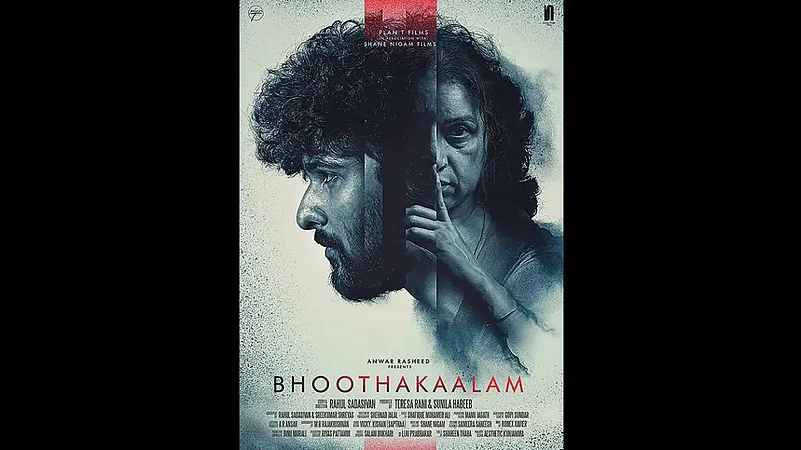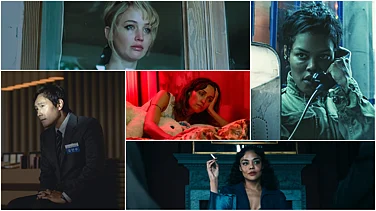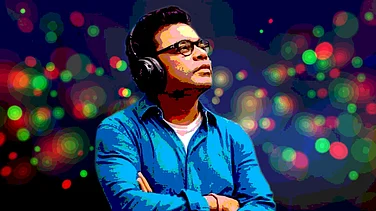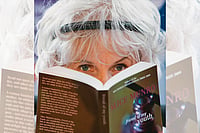If you like your horror cinema to be easily classified—the common categories include “psychological” vs “supernatural”, or “quietly creepy” vs “full of jump scares”—you might be intrigued by the Malayalam film Bhoothakaalam, about a middle-aged woman and her son battling personal demons. In tone, setting and characterisation, this is a subdued work rather than one of explicit terrors. Asha (Revathi) and Vinu (Shane Nigam) seem afflicted by a sadness, the causes of which aren’t spelt out, though we grasp things about their past and present—a husband/father who died, leaving behind unhappiness and debt; a boy who misses him and sees his mother as clinging; a woman who can’t conceive of life without her son.
But while Bhoothakaalam maintains its grounded tone, it also has things that go bump in the night… and there is a haunted house too (albeit, in a bright residential area, far from the archetype of the isolated mansion). Without giving away too much, midway through the narrative there is a slight shift in our perceptions about what is going on, and a sense that subtle and supernatural can go together.

“Isn’t it just a house?” someone says when the possibility of demoniac spirits comes up, “made of stones, cement, mud, wood.” But what if a brick-and-mortar entity can respond to the conflicts of the people living in it? In one tense dinner-table scene, as mother and son start to argue and voices are raised, the camera pointedly focuses on the window curtains in the background—they might be moving a little more than expected, or is it just the wind? Here and elsewhere, one gets the impression that the house is somehow feeding on their negative energies. Asha and Vinu have become distanced from each other, and they need to rebuild their trust for the monster to be defeated.
Which means that like so many horror films, Bhoothakaalam is essentially about loneliness and alienation. “If he leaves, who will I have? Won’t I be alone here?” Asha asks in an early scene when it is suggested that Vinu travels elsewhere for a good job. There is an echo in her despairing words of the most famous horror film about an intense mother-son bond, Alfred Hitchcock’s Psycho, in which a young man is seemingly tied forever by an umbilical cord, unable to move away from his mother’s presence.

When I first watched Psycho as a shy adolescent living with a recently divorced mother, the film touched me in ways I couldn’t articulate. There was something so powerful about the sense of decay and stasis, about the vulnerable awkwardness on Norman Bates’s face as he tried to express his feelings to a stranger. Or his indignant response to the accusation that he might be trying to leave the Bates Motel and start a new life elsewhere. (“This place happens to be my only world. I grew up in that house up there.”) Today I still spend much of my working day in the flat that my mother and I moved to in 1987, and Psycho is never far from my mind when I wander its empty rooms—including the room she died in a few years ago. I think about how our living spaces can inhabit us as much as we inhabit them.

The horror genre offers plenty of room for reflections of this sort. Perhaps this is also why it is a surprise to learn, late in Bhoothakaalam, that Asha and Vinu had been living in their house for a short time, and on rent—I had assumed it was an old family house where their entire personal histories had unfolded.
ALSO READ: The Ghost As A Metaphor In Bengali Cinema
Horror literature and cinema have long mined the idea of a haunted house as a mirror to the states of mind of the people in it—from Shirley Jackson’s iconic novel The Haunting of Hill House (about experiments in fear conducted by a doctor with a small group of people) to Stephen King’s The Shining (a writer takes up a position as the off-season caretaker of a large, snowbound hotel and finds the place exerting a spell on him) to Sarah Waters’s The Little Stranger (a family that was once well-off continues to stay in their crumbling estate). The filmed adaptations of these works make visual or aural links between the ominous setting and the dark crannies in the inhabitants’ minds. In the 1963 film The Haunting—adapted from Jackson’s novel—a distorting lens suggests the oddness of the house’s spaces; Stanley Kubrick’s 1980 film The Shining uses long Steadicam takes that emphasise the agoraphobia-inducing vastness of the hotel.

Many modern horror filmmakers make a fetish out of being restrained and realistic, as if there were something inherently distasteful about making viewers jump out of their seats in the old way (or maybe it’s just that the popcorn is now so expensive that nobody wants to risk spilling it!).
ALSO READ: The ‘Spirit’Of Filmmaking
But once in a while we still find films like Jennifer Kent’s The Babadook (2014), which successfully operate in multiple modes. This is at one level a “creature feature”—the half-glimpsed bogeyman is as otherworldly as they come—but the story’s heart is the relationship between a protective single mother and her little boy whom others see as disturbed. Other acclaimed recent films—from Ari Aster’s Midsommar and Hereditary to Jordan Peele’s Us and John Krasinski’s A Quiet Place—also get their bleakness, and in some cases their redemptive power, from strained filial relationships—a young woman tries to cope with the sudden suicide-murder of her family, another family has to perfectly plan and synchronise its every action if it wants to stay alive in a dystopian scenario.
***
While the alienation theme can derive from complex parent-child relationships of this sort, there are other ways of being cut off from the “normal” world. “I must have gotten off the main road,” says Marion Crane, a young woman who finds herself at the Bates Motel after having escaped her home-town with stolen money. “Nobody ever stops here anymore unless they’ve done that,” replies Norman. Marion’s theft has led her, literally, into the “galat rasta” and a subterranean world.
ALSO READ: Resident Evil: The Zombie Apocalypse In Goa

The trope of the lonely or isolated woman has also fuelled many classics over the decades, going back at least to Val Lewton’s 1942 Cat People (and extending forward through the 1970s and 80s to films targeted at male viewers, which centred on the voyeuristic thrills that came from seeing a woman in peril). In these stories, the protagonist might be alienated by circumstances or personality, and dealing with some combination of mental illness or societal repression. There are obvious subtexts, especially when the story is set in conservative frameworks where it is seen as undesirable for women to be untethered (or “too independent”).
Thus the pregnant Rosemary in Rosemary’s Baby (1968) needs to be controlled by smiling neighbours who are really a satanic cult; they can’t allow her autonomy, she must be cut off from close friends who might form a support circle. In the poignant French film Eyes Without a Face (1960), a disfigured young woman wanders sadly around her large mansion while her surgeon father—another concerned but controlling parent—tries to restore her face. In the Japanese classic Onibaba (1964), an old woman becomes unhinged as she realises that she might be abandoned by her daughter-in-law (they live alone in the grasslands, stealing from wounded samurai). And in one of my favourite B-movies, the cheaply made but very effective Carnival of Souls (1962), a woman named Mary emerges from a lake after an accident and, disoriented, tries to negotiate her surroundings. Is she literally dead—a zombie—or is her confusion an allegory for trying to make a fresh start and repeatedly coming up against dead ends?

It’s easy to imagine some of these lonely-people films in conversation across space and time. For instance, think of Roman Polanski’s Repulsion (1965), Pavan Kirpalani’s Phobia (2016), and Ram Gopal Varma’s Kaun? (1999). In each, a woman is in a confined space, trying to make sense of her predicament. The specifics are different—one character may be sexually repressed, another might be the caged victim of a domineering man, the third may be dealing with a menacing threat outside the house—but each of them is trying to keep monsters, real or imagined, at bay.
ALSO READ: An Allegory Written In Blood
But to my mind, the best horror film about loneliness and despair is one that doesn’t yet exist—it is the never-made film version of one of the scariest, saddest books I have read, Helen McCloy’s Through a Glass Darkly. The story centres on this indelible idea—a melancholy young woman named Faustina is faced with the possibility that she has a ghostly doppelganger, a shadow self that is impersonating her and getting her into trouble, and will eventually come to claim her soul. “In early childhood,” she muses, “You stare at your face in the mirror and look at your hands and feet and say to yourself: I am me. I am not anyone else. Yet, something inside you goes on feeling that it’s not quite true.” The book’s climax involves both this spectral double and a reflecting surface in a house—a perfect depiction of inner and outer spaces—glass and cement and a tormented mind—coming together to devastating effect. If there is ever a film of this novel, make sure to hold that expensive popcorn tub as tightly as you can.
(This appeared in the print edition as "Under the Skin")
(Views expressed are personal)
ALSO READ
Jai Arjun Singh is an independent critic and author


























